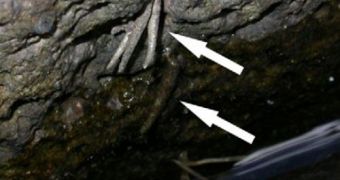Biologists have known for a long time that moths in the genus Hyposmocom, based in Hawaii, were a bit different from other insects of their kind. One of the species in this genus, for example, produces caterpillars that have taken a liking in attacking and eating tree snails. In addition to being a lot larger than they are, the snails are also covered in a thick, very solid shell, which makes you wonder how the soft caterpillars get through. But this is not by far an isolated case of weirdness. For example, at least another 12 species of the genus were recently found to be harboring their caterpillars under water.
They live completely submerged for periods of time lasting up to a few weeks, and investigators are completely puzzled by this. That is to say, it's not every day that you get to witness the actions of an amphibious caterpillar, especially when it defies reason by remaining submerged for such a long time. “I couldn't believe it. I assumed initially they were terrestrial caterpillars […] how were they holding their breath?” says of the first time when he witnessed the creatures University of Hawaii in Honolulu evolutionary biologist Daniel Rubinoff.
He is also the coauthor of a new study accompanying the findings, which appears in the March 22 online issue of the respected publication Proceedings of the National Academy of Sciences (PNAS). The paper is entitled “Multiple aquatic invasions by an endemic, terrestrial Hawaiian moth radiation.” The weird thing about the submerged moths is 1) that they did not appear to be surviving on stored oxygen, and 2) that they never broke the surface of the water even once for weeks. Even the most advanced amphibians have to come out for air at one point or another.
The team conducting the investigation noticed a very peculiar aspect. Whenever the caterpillars were taken out of the fast-running water and placed in stationary water, they drowned immediately. According to the group, this would seem to suggest that something in the rapid supply of oxygen that can be found in fast-running water may be allowing for them to remain submerged for such a long time. The scientists hypothesize that the creatures may be absorbing the chemical directly through pores in their bodies, as no evidence of gills or other similar structures were found on their bodies.
(c) 2010, Los Angeles Times. Distributed by McClatchy-Tribune Information Services. Via PhysOrg

 14 DAY TRIAL //
14 DAY TRIAL //